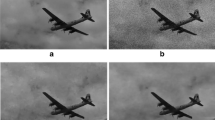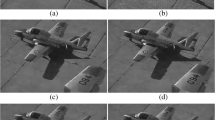Abstract
Regularization parameter selection for image denoising has always been a hot issue. In this paper, an adaptive regularization parameter selection method is exploited for the Gaussian Mixture Model (GMM) based image restoration by combining the gradient matching and the local entropy of the image, which varies with different regions of the image and has a good robustness to noise. Experiment results demonstrate that our proposed adaptive regularization parameter for GMM based image restoration method performs comparatively well, both in visual effects and quantitative evaluations.
Access provided by CONRICYT-eBooks. Download conference paper PDF
Similar content being viewed by others
Keywords
1 Introduction
In recent years, the digital image has been widely used in our daily life. However, during the acquiring process, it is inevitably corrupted by the degraded factors, mainly including the precision in measurements of sensors, motion blur, lens aberration. Therefore, in order to obtain the high quality images, there has been a growing attention in image denoising techniques.
In the past decades, a great variety of image recovery methods have been presented, such as the regularization methods based [1], the image sparse representation based [2], the mixture models learning based [3], and so on. Among them, the mixture models learning based, particularly the Gaussian Mixture Model (GMM) [3] learning based image restoration method has proven its effectiveness and achieved good results.
Recently, regularization parameter selection has received much attention, which has a great effect on preserving more details of image when denoising. At present, numerous methods for regularization parameter selection have been put forward, including the discrepancy principle based [4], the residual image statistics (RIS) based [5], the L-curve and gradient based [6, 7]. In this paper, we focus on the image gradient based regularization parameter selection problem for GMM based image restoration model. Unfortunately, the image gradient is sensitive to noise and can’t acquire satisfying results when the image is corrupted seriously. By observing that the local entropy of image has a good robustness to noise, we attempt to construct a new adaptive regularization parameter using image gradient matching and the local entropy of image. Moreover, we analyze the relationship between the regularization parameters of the data-fidelity term and gradient-fidelity term, and propose a novel regularization parameter scheme for GMM based image restoration method for preserving more small-scale textures and details of images.
2 Proposed Method
2.1 GMM Based Image Recovery Model
Given an image \( u \) with \( N \) pixels, let \( u_{i} (i = 1,2, \ldots ,N) \) denote an image patch with the size of \( \sqrt L \times \sqrt L \), obtained by \( u_{i} = R_{i} u \), where \( R_{i} \) denotes an operator for extracting image patch \( u_{i} \) from image \( u \) at position \( i \). The joint conditional density of the image is given by:
where \( \pi_{j} \) is the mixing weights, \( K \) is the number of mixture components, \( \mu_{j} \) and \( \varSigma_{j} \) are the corresponding mean and covariance matrix.
Then we learn the patch priors using (1) by introducing the EPLL, and the optimization is presented as follows:
where \( \lambda \) is the regularization parameter.
2.2 Proposed Method with Adaptive Regularization Parameter
Regularization parameter plays an important role in image restoration. As explained in [6, 7], an adaptive regularization parameter for the fidelity term is valid for preserving fine structures of images. In this paper, so as to acquire more satisfying denoised results, a novel Gaussian mixture model based image denoising method with adaptive data-fidelity term and gradient-fidelity term is presented as follows:
where \( \nabla \) denotes the image gradient, \( G_{\sigma } \) is a Gaussian filter operator, the second term is the gradient fidelity term, \( \lambda \) and \( \alpha \) are the weight coefficients and can be chosen as a function of the gradient and local entropy of corrupted image in the following form:
where \( k \) is a given constant, \( k_{0} \) is a threshold value, \( g(|\nabla u|) \) is designed by:
where \( k_{1} \) is also a threshold value, when \( \nabla u \) is large, \( g(|\nabla u|) \to 2 \), when \( \nabla u \to 0 \), \( g(|\nabla u|) \to 2 + k_{1} \), \( E(x,y) \) is the local entropy of image and \( f(E(x,y)) \) is defined as follows:
where \( M \) is the maximum of image gradient norm.
The regularization parameters vary with different regions of the image. \( \lambda (x,y) \) is set to be small in the smooth regions of image, while \( \alpha (x,y) \) is large so as to remove much noise while guarantee the similarity between the restored image and the corrupted one. At the edge of image, \( \alpha (x,y) \) is small but \( \lambda (x,y) \) is large, for preserving more edges of the image. Meanwhile, the given \( k \) can help balance the regularization parameters \( \lambda (x,y) \) and \( \alpha (x,y) \), and make them have proper values in different regions of the image for preserving more details of image while smoothing noises.
Here, we employ the Half Quadratic Splitting algorithm to solve (3). The Eq. (3) is equivalently transformed into the following function by introducing a set of auxiliary variables \( \{ z_{i} \} \) as follows:
where \( \beta \) is the penalty parameter.
For solving (7), at first, we choose the most likely Gaussian mixing weight \( j_{\hbox{max} } \) for each patch \( R_{i} u \), then Eq. (7) is minimized by alternatively updating \( z_{i} \) and \( u \):
Where \( I \) is the identity matrix, \( \Delta t \) is the time step, \( \mu_{{j_{\hbox{max} } }} \) and \( \varSigma_{{j_{\hbox{max} } }} \) are the corresponding mean and covariance matrix with the mixing weight \( j_{\hbox{max} } \).
In summary, our suggested algorithm can be implemented as follows:

3 Implementation and Experiment Results
In our experiments, the GMM with 200 mixture components is learned from a set of \( 2 \times 10^{6} \) images patches sampled from the Berkeley Segmentation Database Benchmark (BSDS300). All the images used in our experiments are generated by Gaussian noise with zero mean and standard variance \( \sigma = 25 \). We compare our proposed method with the original EPLL and the EPLL coupling gradient fidelity term with fixed regularization parameters. The parameters in our proposed method are as follows: the image patch size \( \sqrt L = 8 \), the noise standard variance \( \sigma = 25 \), the weighted coefficients \( \beta = 1/\sigma^{2} * [1\,{\kern 1pt} \;4\;\,{\kern 1pt} 8\,\;{\kern 1pt} 16] \), the size of local entropy of the image is set as \( 3 \times 3 \), the constant \( k_{0} = 1/\sigma^{2} \), \( k_{1} = 7 \) and \( k = L/2\sigma^{2} \).
Figure 1 demonstrates the denoised results of the original EPLL and our proposed method with adaptive \( \lambda ,\alpha \) on Test1 image (i.e., No. 3096). The related quantitative comparison, in terms of peak signal to noise ratio (PSNR) and signal to noise ratio (SNR), are shown in Table 1. The Fig. 1(a) and (b) are respectively the original image and noisy image. The Fig. 1(c) shows that the denoised result obtained by the original EPLL, and we can see that some regions of the image are not smooth. In contrast, the Fig. 1(d) acquired by our method achieves a better result. This is probably due to the fact that our proposed method incorporates the gradient fidelity term with the EPLL, which can help preserve more details of image and make the degraded image smoother during the denoising procedure.
Figure 2 demonstrates the denoised results of our proposed method and the comparison with the EPLL with fixed \( \lambda ,\alpha \) on Barbara image. The corresponding PSNR and SNR are shown in Table 2. We enlarge the right shoulder of denoised result and put it on the right of image. From the result in Fig. 2(c) we can see that some small-scale textures of the image are not clear, while the result of our proposed method in Fig. 2(d) preserve more textures. This is probably on account of the fact that the parameters \( \lambda ,\alpha \) of our proposed method vary with different regions of the image. They can change their values automatically according to the image information and help preserve more fine structures in image. Therefore, by comparing, our proposed adaptive method outperforms the EPLL with a fixed \( \lambda ,\alpha \) both in PSNR and SNR.
4 Conclusions
The GMM based image denoising method has received much attention in recent years. In this paper, we devote to the research of the regularization parameter selection for the GMM based image denoising model. We construct an adaptive regularization parameter coupling the local entropy of the image, which varies with different regions of the image and is robust to noise. Our proposed method achieves a satisfying denoised result and shows a clear improvement compared with the original EPLL algorithm in image denoising.
References
Wen, Y.W., Chan, R.H.: Parameter selection for total-variation-based image restoration using discrepancy principle. IEEE Trans. Image Process. 21, 1770–1781 (2012)
Peleg, T., Eldar, Y.C., Elad, M.: Exploiting statistical dependencies in sparse representations for signal recovery[J]. IEEE Trans. Signal Process. 60, 2286–2303 (2012)
Zoran, D., Weiss, Y.: From learning models of natural image patches to whole image restoration. In: 2011 IEEE International Conference on Computer Vision (ICCV), pp. 479–486. IEEE (2011)
Wen, Y.W., Chan, R.H.: Parameter selection for total-variation-based image restoration using discrepancy principle. IEEE Trans. Image Process. 21, 1770–1781 (2012)
Gilboa, G., Sochen, N., Zeevi, Y.Y.: Variational denoising of partly textured images by spatially varying constraints. IEEE Trans. Image Process. 15, 2281–2289 (2006)
Yuan, Q., Zhang, L., Shen, H., et al.: Adaptive multiple-frame image super-resolution based on U-curve. IEEE Trans. Image Process. 19, 3157–3170 (2010)
Xie, C.C., Hu, X.L.: On a spatially varied gradient fidelity term in PDE based image denoising. In: 2010 3rd International Congress on Image and Signal Processing (CISP), vol. 2, pp. 835–838. IEEE (2010)
Acknowledgments
This work was supported in part by the NSFC (Grants 61402234 and 61402235) and the PAPD.
Author information
Authors and Affiliations
Corresponding author
Editor information
Editors and Affiliations
Rights and permissions
Copyright information
© 2017 Springer Nature Singapore Pte Ltd.
About this paper
Cite this paper
Zhang, J.W., Liu, J., Zheng, Y.H., Wang, J. (2017). Regularization Parameter Selection for Gaussian Mixture Model Based Image Denoising Method. In: Park, J., Pan, Y., Yi, G., Loia, V. (eds) Advances in Computer Science and Ubiquitous Computing. UCAWSN CUTE CSA 2016 2016 2016. Lecture Notes in Electrical Engineering, vol 421. Springer, Singapore. https://doi.org/10.1007/978-981-10-3023-9_47
Download citation
DOI: https://doi.org/10.1007/978-981-10-3023-9_47
Published:
Publisher Name: Springer, Singapore
Print ISBN: 978-981-10-3022-2
Online ISBN: 978-981-10-3023-9
eBook Packages: EngineeringEngineering (R0)






